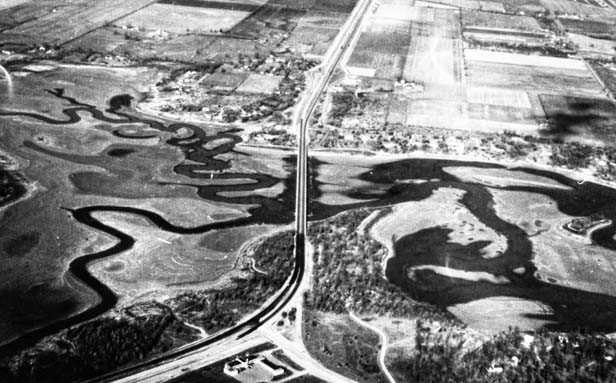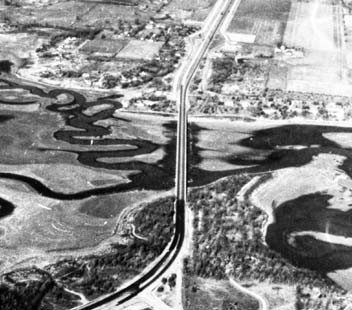
It’s hard to think of anything good about droughts, but they have turned up some interesting finds. On Aug. 6, the Illinois State Museum announced a new acquisition that resulted from the current dry spell – a local family gave the museum some bones they found on the Sangamon River. The bones, which were visible because the river’s level had dropped, were from an extinct muskox. These hulking, furry creatures lived here during the last Ice Age, according to the Museum’s website.
During the severe central Illinois drought of the 1950s, there were several equally unusual discoveries in the shriveling Lake Springfield. That drought began in early 1952 and didn’t end until 1955. In the middle of that period Lake Springfield dropped to its lowest level since it was created in the 1930s, according to City Water, Light and Power’s website. On Dec. 29, 1954, the lake was 13 feet below its full level of 560 feet. (As a comparison, as of Aug. 10 of this year, the lake was three feet beneath full pool.)
Among the unusual items that showed up on the lake’s bottom during the historic 1950s drought was a cash register discovered beneath Cotton Hill bridge on Nov. 2, 1953, according to a newspaper article dated the following day. (All of the articles referred to in this column came from a file about Lake Springfield during the 1950s kept by Lincoln Library’s Sangamon Valley Collection.) “The register was submerged in about ten inches of mud, and eight inches of water. Only the keys showed above the low water of Lake Springfield,” the article said.
By the next year, 1954, the lake was so low that its two beaches couldn’t open, and another discovery popped up. This time it was a road. Part of the original Route 66 had been submerged when the lake was created, but the long dry spell freed it from its watery grave. The strip of highway was even drivable. Fishermen parked on it to reach prime fishing locations. “The road stretches all the way across the lake, except for a gap near the south end where a bridge spanned Sugar Creek before the lake was formed,” said a June 9, 1954, article. The old Mother Road still had her brick paving and some of her deteriorated safety barrier.
A smaller but more mysterious find emerged on Sept. 25, 1954 – burglars’ loot. “Three guns, a safe and cash register, auto wheels and tires, and (car) keys and jewelry” were discovered by lake police at the “South Sixth Street bridge,” according to an article from the same day. The police figured burglars had dumped their bounty to avoid suspicion. The loot was taken to the state laboratory where workers examined it for identifying details. “Chief (of the Lake Police Clarence) Spence said that this is the third time lake police have found guns in the water, and that the police have been keeping constant lookout for such caches,” the article said.
As the lake water continued to plunge, the next month brought another discovery, a long-lost boat. It was a “22-foot steel lifeboat” used by the Sea Scouts during World War II, according to an Oct. 8, 1954, article. (The Sea Scouts is a program for teens that emphasizes water activities and is overseen by the Boy Scouts.) A local man bought the boat from the Scouts and stowed it on the lake, but it was lost during a 1945 storm. The owner had the lake dragged to find it, but was unsuccessful. After hauling the partly submerged boat from the drought-ravaged lakebed in 1954, he said its hull was salvageable.
A year later, on June 17, 1955, the lake had regained enough water that the beaches reopened; they’d been closed since 1953. On July 15, 1955, the lake finally reached full level for the first time in three years.
There’s an interesting side note about the lake’s beaches and the drought; the beginning of the drought marked their desegregation. According to the July 15, 1952, Illinois State Register, then Commissioner of Public Property John Hunter, who oversaw the lake, met with local members of the National Association for the Advancement of Colored People the day before and agreed to their request to open both beaches to all races. Previously, the beach house swimming area was only open to whites and Bridgeview Beach, on the lake’s south side, off of Lakewood Drive, was only open to African-Americans.
Contact Tara McAndrew at [email protected].


